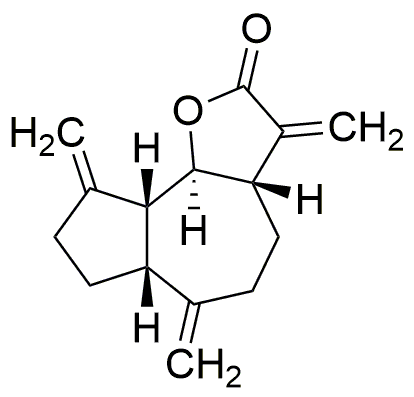Dehydrocostus lactone is widely utilized in research focused on:
- Fragrance Industry: This compound is valued for its pleasant aroma, making it a popular choice in perfumes and cosmetics. Its unique scent profile can enhance product appeal, attracting consumers looking for distinctive fragrances.
- Flavoring Agent: It is used in food and beverage applications to impart a unique flavor. Manufacturers often incorporate it into specialty foods to create innovative taste experiences, appealing to gourmet markets.
- Pharmaceutical Applications: Dehydrocostus lactone has shown potential in medicinal chemistry, particularly in developing anti-inflammatory and antimicrobial agents. Researchers are exploring its efficacy in treating various health conditions, providing new options for therapies.
- Natural Insect Repellent: This compound is being studied for its insect-repelling properties, offering a natural alternative to synthetic pesticides. This application is particularly relevant for organic farming and eco-friendly pest control solutions.
- Cosmetic Formulations: Its antioxidant properties make it a valuable ingredient in skincare products. Formulators are integrating it into creams and lotions to enhance skin health, appealing to consumers interested in natural and effective skincare solutions.
General Information
Properties
Safety and Regulations
Applications
Dehydrocostus lactone is widely utilized in research focused on:
- Fragrance Industry: This compound is valued for its pleasant aroma, making it a popular choice in perfumes and cosmetics. Its unique scent profile can enhance product appeal, attracting consumers looking for distinctive fragrances.
- Flavoring Agent: It is used in food and beverage applications to impart a unique flavor. Manufacturers often incorporate it into specialty foods to create innovative taste experiences, appealing to gourmet markets.
- Pharmaceutical Applications: Dehydrocostus lactone has shown potential in medicinal chemistry, particularly in developing anti-inflammatory and antimicrobial agents. Researchers are exploring its efficacy in treating various health conditions, providing new options for therapies.
- Natural Insect Repellent: This compound is being studied for its insect-repelling properties, offering a natural alternative to synthetic pesticides. This application is particularly relevant for organic farming and eco-friendly pest control solutions.
- Cosmetic Formulations: Its antioxidant properties make it a valuable ingredient in skincare products. Formulators are integrating it into creams and lotions to enhance skin health, appealing to consumers interested in natural and effective skincare solutions.
Documents
Safety Data Sheets (SDS)
The SDS provides comprehensive safety information on handling, storage, and disposal of the product.
Product Specification (PS)
The PS provides a comprehensive breakdown of the product’s properties, including chemical composition, physical state, purity, and storage requirements. It also details acceptable quality ranges and the product's intended applications.
Certificates of Analysis (COA)
Search for Certificates of Analysis (COA) by entering the products Lot Number. Lot and Batch Numbers can be found on a product’s label following the words ‘Lot’ or ‘Batch’.
*Catalog Number
*Lot Number
Certificates Of Origin (COO)
This COO confirms the country where the product was manufactured, and also details the materials and components used in it and whether it is derived from natural, synthetic, or other specific sources. This certificate may be required for customs, trade, and regulatory compliance.
*Catalog Number
*Lot Number
Safety Data Sheets (SDS)
The SDS provides comprehensive safety information on handling, storage, and disposal of the product.
DownloadProduct Specification (PS)
The PS provides a comprehensive breakdown of the product’s properties, including chemical composition, physical state, purity, and storage requirements. It also details acceptable quality ranges and the product's intended applications.
DownloadCertificates of Analysis (COA)
Search for Certificates of Analysis (COA) by entering the products Lot Number. Lot and Batch Numbers can be found on a product’s label following the words ‘Lot’ or ‘Batch’.
*Catalog Number
*Lot Number
Certificates Of Origin (COO)
This COO confirms the country where the product was manufactured, and also details the materials and components used in it and whether it is derived from natural, synthetic, or other specific sources. This certificate may be required for customs, trade, and regulatory compliance.


